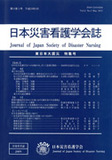Japanese
English
- 有料閲覧
- Abstract 文献概要
- 参考文献 Reference
要約
2004年10月に発生した新潟中越地震は、中山間地に大きな被害をもたらした。今回、A地区の被災者を対象に震災から4年、生活環境の変化と健康問題についてアンケート調査を実施した。全世帯主123名のうち42名から回答を得た。
調査の結果、A地区の人々は、過疎と高齢化の急速な進展による地域の疲弊と経済的困窮にともなう生活不安を感じていた。健康問題に関しては、震災後「悪くなった・少し悪くなった」は4割あり、住民からは、診療所等の保健サービスの充実が期待されていた。被災者の経済的困窮に対しては、行政による財政的支援は重要であるが、一方、住民自身による復興への自発的行動も復興を進めてゆくために必要であることが理解された。A地区では、様々な活動が震災2年目ころから始まっており、この活動には、震災時ボランティアたちの参加もある。アンケート回答者の4割がボランティアの存在を評価していることからも、継続的なかかわりが復興してゆく地域には必要であることが示唆された。
Abstract
The Niigata-Chuetsu Earthquake occurred in October 2004, devastating rural mountainous areas in Niigata Prefecture. This survey targeted victims in one of the disaster areas(District "A")four years after the event. We examined changes in living conditions as well as health problems that had emerged during that time. Responses were received from 42 of the 123 household heads to whom the questionnaire was sent.
The survey results show that the residents of District A were worried about living in a region battered by economic poverty and a rapid pace of depopulation and aging. Regarding health problems after the earthquake, 40% replied that their condition had become "worse or a little worse." The residents of District A had looked forward to enhanced of health services such as clinics. They also showed awareness that even though government-funded reconstruction programs were vital, spontaneous locally initiated activities were also important. In District A, a variety of activities began around the second year following after earthquake. Volunteers who had come to Niigata to help in the wake of the earthquake also returned to participate in these activities. Forty percent of survey respondents responded favorably to the presence of the volunteers, suggesting their importance for continuing reconstruction efforts.
Copyright © 2011, Japan Society of Disaster Nursing All rights reserved.


